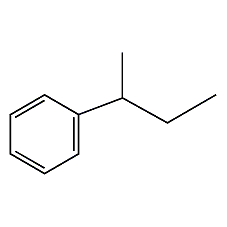
Structural formula
| Business number | 03QN |
|---|---|
| Molecular formula | C10H14 |
| Molecular weight | 134.22 |
| label |
Other butylbenzene, (1-Methylpropyl)benzene, 2-phenylbutane, Second butylbenzene, sec-butylbenzene, 2-Phenylbutane, (1-Methylpropyl)benzene, plasticizer, Surfactant, solvent for aromatic hydrocarbons |
Numbering system
CAS number:135-98-8
MDL number:MFCD00009329
EINECS number:205-227-0
RTECS number:CY9100000
BRN number:1903902
PubChem number:24851741
Physical property data
1. Properties: colorless and transparent liquid[1]
2. Melting point (℃): -82.7[2]
3. Boiling point (℃): 173.5[3]
4. Relative density (water=1): 0.86[4]
5. Relative vapor density (air=1): 4.62[5]
6. Saturated vapor pressure (kPa): 0.13 (18.6℃) [6]
7. Critical temperature (℃): 377[7]
8. Critical pressure (MPa) : 3.14[8]
9. Octanol/water partition coefficient: 4.57[9]
10. Flash point (℃): 45[10]
11. Ignition temperature (℃): 415[11]
12 . Explosion upper limit (%): 6.9[12]
13. Explosion lower limit (%): 0.8[13]
14. Solubility: Insoluble in water, soluble in most organic solvents such as ethanol, ether, and benzene. [14]
15. Refractive index (20ºC): 1.49020
16. Refractive index (25ºC): 1.48779
17 . Viscosity (mPa·s, 20ºC): 28.53
18. Viscosity (mPa·s, 30ºC): 27.53
19. Heat of evaporation (KJ/mol, 25ºC): – 49.53
20. Heat of evaporation (KJ/mol, b.p.): -37.97
21. Heat of fusion (KJ/mol): -9.84
22. Heat of formation (KJ/mol, 25ºC): 66.5282×103
23. Solubility (%, water, 20ºC): 0.0317
24. Steam Pressure (kPa, 25ºC): 0.23
25. Vapor pressure (kPa, 76.26ºC): 4.00
26. Vapor pressure (kPa, 105.986ºC): 13.33
27. Solubility parameter (J·cm-3)0.5: 17.428
28. van der Waals area (cm 2·mol-1): 1.146×1010
29. van der Waals volume (cm3 sup>·mol-1): 90.190
30. Gas phase standard combustion heat (enthalpy) (kJ·mol-1): -5918.56
31. Gas phase standard claimed heat (enthalpy) (kJ·mol-1): -17.36
32. Liquid phase standard combustion heat (enthalpy) ( kJ·mol-1): -5869.52
33. Liquid phase standard claims heat (enthalpy) (kJ·mol-1): -66.40
34. Liquid phase standard hot melt (J·mol-1·K-1): 251.7
Toxicological data
1. Acute toxicity[15]
LD50: 6300mg/kg (rat oral); >16ml (13760mg)/kg (rabbit transdermal)
2. Irritation[16]
Rabbit transdermal: 100mg (24h), moderate irritation.
Rabbit eye: 500mg (24h), mild irritation.
Ecological data
1. Ecotoxicity No data yet
2. Biodegradability[17] Activated sludge method , the initial concentration is 100mg/L, and the degradation is 56%~67% after 5 days.
3. Non-biodegradability No data yet
4. Bioaccumulation[18] BCF: 660 (theoretical)
5. Other harmful effects[19] This substance may be harmful to the environment and harmful to aquatic organisms and Birds should be given special attention. Attention should also be paid to accumulation in mammals.
Molecular structure data
1. Molar refractive index: 45.07
2. Molar volume (cm3/mol): 156.0
3. Isotonic specific volume (90.2K ): 362.1
4. Surface tension (3.0 dyne/cm): 29.0
5. Polarizability (0.5 10-24cm 3): 17.86
Compute chemical data
1. Reference value for hydrophobic parameter calculation (XlogP): 4.2
2. Number of hydrogen bond donors: 0
3. Number of hydrogen bond acceptors: 0
4. Number of rotatable chemical bonds: 2
5. Number of tautomers:
6. Topological molecular polar surface area (TPSA): 0
7. Number of heavy atoms: 10
8. Surface charge: 0
9. Complexity: 80
10. Number of isotope atoms: 0
11. Determine the number of atomic stereocenters: 0
12. Uncertain number of atomic stereocenters: 2
13. Determine the number of chemical bond stereocenters Number: 0
14. Number of uncertain chemical bond stereocenters: 0
15. Number of covalent bond units: 1
Properties and stability
1. Stability[20] Stable
2. Incompatible substances[21] Strong oxidants, acids, halogens, etc.
3. Polymerization hazards[22] No polymerization
Storage method
Storage Precautions[23] Stored in a cool, ventilated warehouse. The storage temperature should not exceed 37°C. Keep away from fire and heat sources. Keep container tightly sealed. should be kept away from oxidizer, do not store together. Use explosion-proof lighting and ventilation facilities. It is prohibited to use mechanical equipment and tools that are prone to sparks. The storage area should be equipped with emergency release equipment and suitable containment materials.
Synthesis method
Obtained from the reaction of benzene and sec-butyl chloride. Stir and cool anhydrous benzene and anhydrous aluminum chloride, add sec-butyl chloride dropwise at 0-5°C, and continue stirring for 1 hour after the addition. Cold water was added with stirring, and the reaction mixture was subjected to steam distillation. The distillate is separated from water, dried and then fractionated. The 171-173°C fraction is collected to obtain the finished product with a yield of 77%.
Purpose
Used as solvents, plasticizers, and surfactants for coatings and organic synthesis. [24]

 微信扫一扫打赏
微信扫一扫打赏

